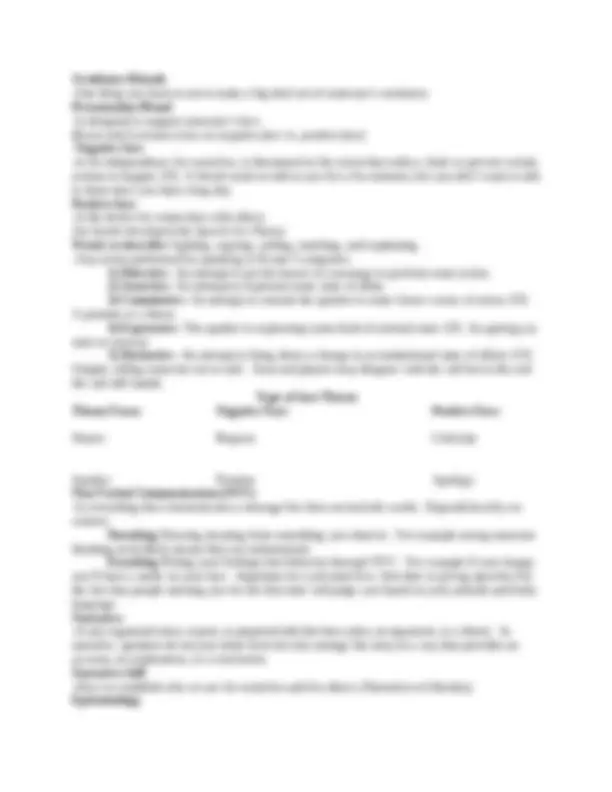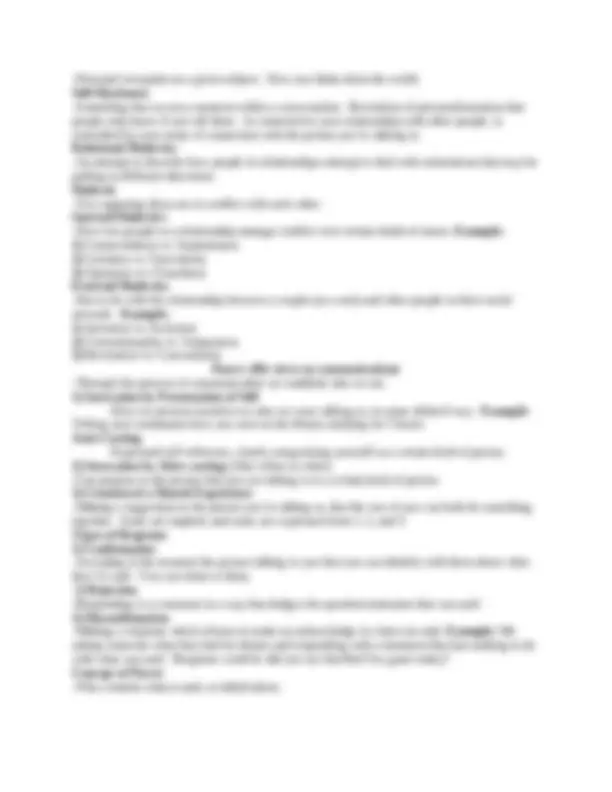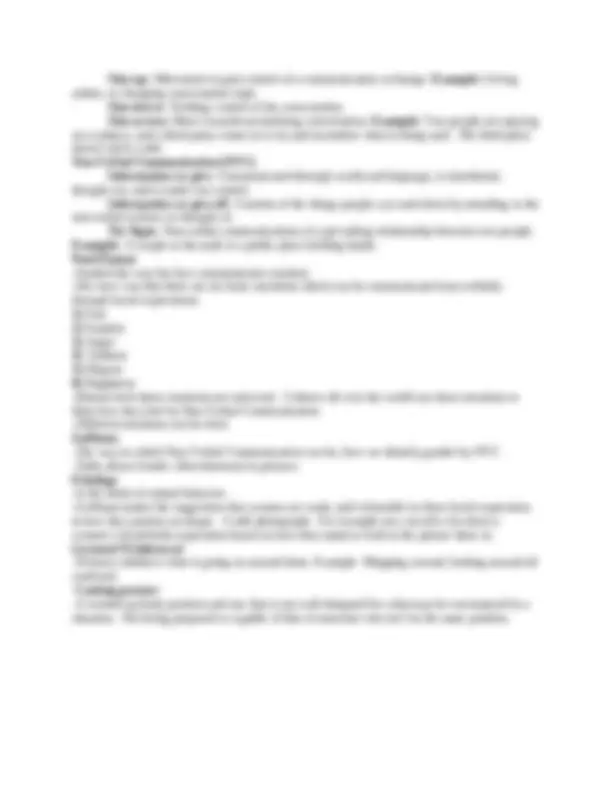





Study with the several resources on Docsity

Earn points by helping other students or get them with a premium plan


Prepare for your exams
Study with the several resources on Docsity

Earn points to download
Earn points by helping other students or get them with a premium plan
Community
Ask the community for help and clear up your study doubts
Discover the best universities in your country according to Docsity users
Free resources
Download our free guides on studying techniques, anxiety management strategies, and thesis advice from Docsity tutors
Communications Midterm Study Guide Material Type: Notes; Class: Communications 1 - Introduction; Subject: Communication; University: SUNY at Albany; Term: Forever 1989;
Typology: Study notes
1 / 5

This page cannot be seen from the preview
Don't miss anything!




Study-Guide First Test Communications Chapter 1 Meaning - The way people communicate through meaning. That they permit a communicator to “go beyond” one item to another. (According to the book) -Different generations may have different meanings on certain words. -All communication involves the use of symbols Denotation vs. Connotation -Denotation refers to the primary association a word has for most members of a given linguistic community. -Connotation refers to other secondary associations a word has for subsets for a given community. (Can differ with different groups in society) EX: police, immigrant -Connotation meaning reflect different ways that people interpret a word. Can up-grade or down-grade the meaning of the word. Either in a positive or negative way. EX: athlete, jock; athlete is the up-grade and jock is the down-grade. Scholar and nerd, scholar is the up-grade and nerd is the down-grade. **Three ways to think about Communication
Chapter 2 Langue -Is the formal grammatical structure of language that you will read about in books on grammar. Parole -Is how people actually use language, with informal and ungrammatical structure that carries meaning to us all the same. How ya’ll doing, is an example, although most down south use that term if you used in on a paper you would get points taken off for bad language. Polysemy
- Multiple meanings for the same word. Words, gestures, and symbols can have their meanings altered on different occasions or in circumstances according to the particulars that frame the talk. -In every communication- whether words, facial expressions, or gestures can have several different meanings, each time you receive a message, you must determine which meaning applies. The Sapir/Whorf hypothesis - Proposes that “you think what you can say,” in other words the words a person or cultures uses will have a direct influence on how the person or culture understands the world. -Naming something not only sticks a label on it but it also differentiates it from the rest of the world; your name tag, for example goes on only your stuff. -Language is the shaper of ideas Intentionality -A basic assumption in communication studies that messages indicate somebody’s intentions or that they are produced intentionally or in a way that gives insight, into the sender’s mental process. Example: Calling someone a dork. Regulators -Are nonverbal actions that indicate to others how you want them to behave or what you want them to do. Example: Shivering when you want someone to close the window or turn up the heat. Ritual model -Is thought of process through which people create and sustain social relationships with each other and by doing so they help to confirm and establish their own sense of identity. -By creating relationships with others, we are able to see who we are. EX: Person 1: Hello, Person 2’s response: Hello God Terms -Are powerful evocative terms that are viewed positively in a society. Examples (for the United States): Liberty, Freedom, Justice and American Dream. Devil Terms -Are powerful evocative terms that are viewed negatively in society. Examples (for the United States): Communism, Torture, Inequality, and Osama Bin Laden. Theory of face -The positive social value that a person claims for him or herself. -Most people have a sense of value, that there worth something. Lost of face- Feeling a lost sense of yourself. EX: Saying hi to someone you know and they don’t respond. Save of face- Defending yourself against someone who offends you. EX: You ask to play basketball with some friends, one says no you suck, your response is then why did I beat you in one-on-one last week?
-Personal viewpoint on a given subject. How you think about the world. Self-Disclosure -Something that occurs a moment within a conversation. Revelation of privatenformation that people only know if you tell them. Is connected to your relationship with other people, is controlled by your sense of connection with the person you’re talking to. Relational Dialectics -An attempt to describe how people in relationships attempt to deal with orientations that may be pulling in different directions. Dialectic -Two opposing ideas are in conflict with each other. Internal Dialectics -How two people in a relationship manage conflict over certain kinds of issues. Example: 1) Connectedness vs. Separateness 2) Certainty vs. Uncertainty 3) Openness vs. Closedness External Dialectics -Has to do with the relationship between a couple (as a unit) and other people in their social network. Example: 1) Inclusion vs. Seclusion 2) Conventionality vs. Uniqueness 3) Revolation vs. Concealment Pearce (His views on communication) -Through the process of communication we establish who we are. 1) Invocation by Presentation of Self -How we present ourselves to who we were talking to, in some defined way. Example: Telling your roommates how you were in the library studying for 5 hours Auto-Casting -Expressed self-reference, clearly categorizing yourself as a certain kind of person. 2) Invocation by Alter-casting (Alter refers to other) -Can purpose to the person that you are talking to is a certain kind of person. 3) Creation of a Shared Experience -Making a suggestion to the person you’re talking to, that the two of you can both do something together. Some are implied, and some are expressed from 1, 2, and 3. **Types of Response
One-up: Movement to gain control of a communication exchange. Example: Giving orders, or changing conversation topic. One-down: Yielding control of the conversation. One-across: Move towards neutralizing conversation. Example: Two people are arguing on a subject, and a third party comes in to try and neutralize what is being said. The third party doesn’t pick a side. Non-Verbal Communication (NVC) Information we give- Communicated through words and language, is intentional, thought out, and is under our control. Information we give off- Consists of the things people can read about by attending to the non-verbal actions we thought of. Tie-Signs- Non-verbal communications of a prevailing relationship between two people. Example: A couple at the mall or a public place holding hands. Paul Ekman -Studied the way the face communicates emotion. -His view was that there are six basic emotions which can be communicated non-verbally through facial expressions. 1) Fear 2) Surprise 3) Anger 4) Sadness 5) Disgust 6) Happiness -Ekman feels these emotions are universal. Cultures all over the world use these emotions to filter how they feel by Non-Verbal Communication -Different emotions can be elicit Goffman -The way in which Non-Verbal Communication can be, how we identify gender by NVC -Talks about Gender Advertisement in pictures Ethology -Is the study of animal behavior -Goffman makes the suggestion that women are weak, and vulnerable in there facial expression in how they portray an image. A still photograph. For example you can tell a lot about a women’s facial/body expression based on how they stand or look in the picture there in. Licensed Withdrawal -Women withdraw what is going on around them. Example: Mopping around, looking around all confused. Canting posture -A twisted up body position and one that is not well designed for what may be encountered in a situation. Not being prepared or capable of that of someone who isn’t in the same position.